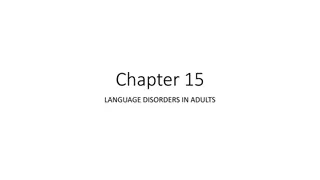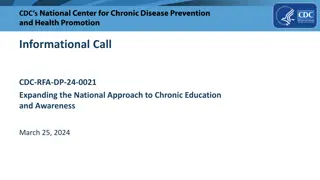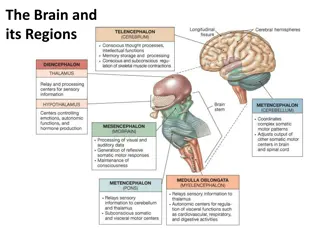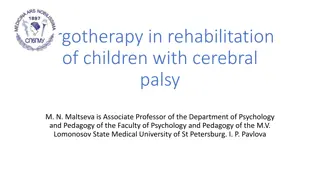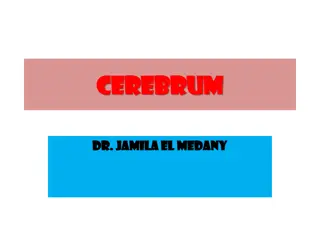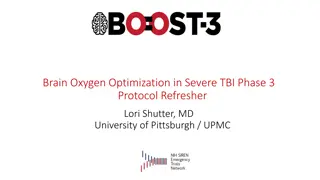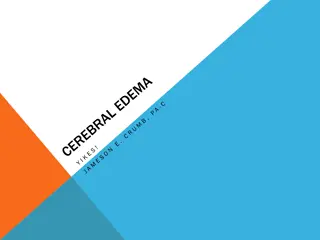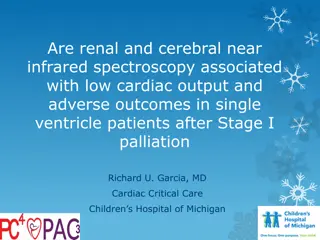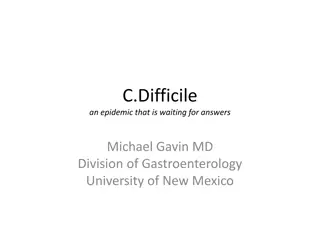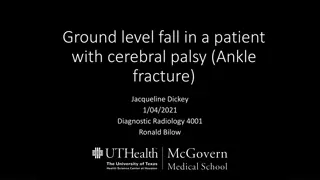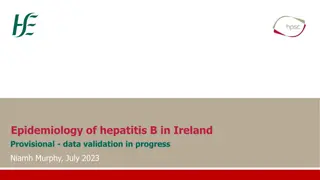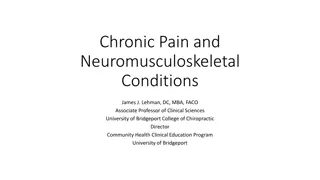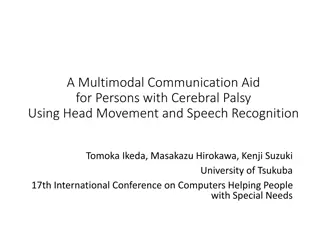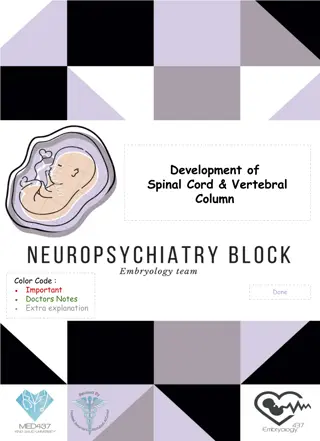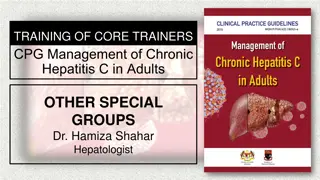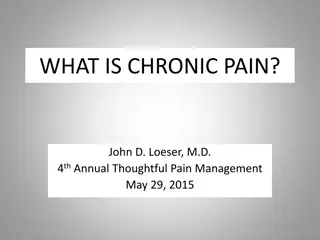Chronic Cerebral and Meningeal Infection Overview
Chronic cerebral and meningeal infections can lead to a range of symptoms over weeks, contrasting with acute infections. Diagnosis involves history, clinical exams, imaging, and lab tests. Various microbial causes, including tuberculosis and brucellosis, can result in chronic neurological issues. This article explores the symptoms, diagnostic features, and potential causes of these infections, with a focus on conditions prevalent in Saudi Arabia.
Download Presentation

Please find below an Image/Link to download the presentation.
The content on the website is provided AS IS for your information and personal use only. It may not be sold, licensed, or shared on other websites without obtaining consent from the author.If you encounter any issues during the download, it is possible that the publisher has removed the file from their server.
You are allowed to download the files provided on this website for personal or commercial use, subject to the condition that they are used lawfully. All files are the property of their respective owners.
The content on the website is provided AS IS for your information and personal use only. It may not be sold, licensed, or shared on other websites without obtaining consent from the author.
E N D
Presentation Transcript
Chronic Cerebral and Meningeal Infection Can produce: They usually have: Slow insidious onset. With progression of signs and symptoms over a period of weeks. They differ from those of acute infection which have: rapid onset of symptoms and signs. They are usually diagnosed, if the neurological syndrome exists for > 4 weeks. Diagnosis: History for Brucellosis and Tuberculosis. Clinical examination. Imaging, X-ray or MRI or ultrasound. Laboratory findings. Neurological disability and, may be. Fatal if not treated. Symptoms and signs of chronic cerebral and meningitis infection: over long period or can be recurrent SYMPTOM: SIGN: Chronic headache +/-Papilloedema Neck or back pain Brudzinski or Kerning 'positive sign of meningeal irritation Change in personality Altered mental status, memory loss, etc Facial weakness Seventh nerve palsy Double vision ,visual loss 3,4,6 th,Nerve palsy Arm and leg weakness Ataxia Clumsiness Hydrocephalus (bc of increase in ICP)
Microbiological Causes Of Chronic Cerebral Infection and Meningitis: Tuberculosis Brucellosis Partially treated acute meningitis Syphilis-caused by Treponema Pallidium Liptosporosis- caused by L.Icter haemorraghia (south america & india) Lyme disease-caused by Borrelia burgdorferi (north american & europe) not common in Saudi Arabia Nocardiosis-caused by Nocardia species (immunocompromised patients) e.g N. Asteroids Cerebral abscesses can also same, preferred as chronic infection in Saudi Arabia Bacterial Most important Cryptococcus neoformans (in HIV patients) Candida species in Saudi Arabia species mainly Candida albicans in immunocompromised patients Aspergillus species Histoplasma capsulatum Fungal Toxoplasma gonodii (most common) acquired from cats Trypanosoiasis:caused by T.gambiense in south american and africa Rare causes : Acanthamoeba spp Parasitic Some virus can some present as chronic meningitis these include: Mumps Herpes simplex HIV Virus
Brucellosis Is a common disease in Saudi Arabia. It affect people who are in contact with domestic animals. consume raw milk and milk products. And through inhalation It usually presents with Pyrexia (fever) of unknown organism of intermittent nature The fever is accompanied by night sweating, in between the attacks of fever the patient is not very ill. Same reasons it can cause chronic cerebral infection and meningitis The commonest causes in Saudi Arabia is Br.melitensis Tuberculosis Is caused by Mycobacterium tuberculosis. Which infect one third of human race. The patient usually presents with fever of long duration. Symptoms of cough and coughing of blood (Haemoptysis) when the chest is affected. In some cases present as meningitis and cerebral infection presenting chronic neurological symptoms and signs. Diagnostic Features of Tuberculous Meningitis Clinical CSF Imaging Fever and headache (for more than 14 days). Vomiting. Altered sensorium or focal. neurological deficit. Pleocytosis (more than 20 cells, more than 60% lymphocytes) Increased protein (more than 100 mg/dl) Low sugar (less than 60% of corresponding blood sugar) India ink studies and microscopy for cryptococcus Neoformans Malignant cells should be negative Exudates in basal cisterns or in sylvian fissure hydrocephalus Infarcts (basal ganglionic) Gyral enhancement Tuberculoma formation
As in acute pyogenic infections, in chronic cerebral and meningeal infections the following CSF finding will be as follows: Laboratory Findings CSF Findings Increased CSF pressure indicating increased intracranial pressure Increased protein level due to presence of inflammatory substance, dead organism, protein and WBC Reduced glucose level ( Normally is 2/3 of serum glucose level) Increased local white cell count but in chronic infection the differential shows lymphocytosis while in acute infections there is increased % of polymorph Gram stain can same time rarely shows causative organism Z-N Stain can show AFB of T.B while modified Z-N can show Nocardia VDRL and other serological causes for syphilis Wet preparation of CSF for fungal and parasite India ink for Cryptococcus neoforman Culture for CSF for Brucella,T.B Mycobacterium tuberculosis, Leplospira other Bacteria Mainly related to the laboratory examination of cerebrospinal fluid including: Collect of 2-5 ml of CSF and checking for the pressure (other infections 1ml but TB stick with mycolic.acid) Biochemical investigation for: Total protein Glucose level in comparison to the serum glucose level Microscopy: Presence of organism Total white cell count Differential count mainly for: Polymorphic Lymphocytes Neutrophil Laboratory Diagnosis Mantoux test, Tuberculin skin test(TST) Chest x-ray for primary focus CSF microscopy for AFB CSF culture a solid medium L.J or fluid medium PCR or other molecular biopsy test for presence of bacterial element Culture of CSF for Brucella Serology for Brucella Treatment Tuberculosis Brucellosis For the first 2 months: A. Rifampicin B. Isoniazid (INH) C. Ethambutol D. Pyrazinamide For the next 4-6 months: A. Rifampicin B. INH Two of the following 3 drugs: A. Tetracycline B. Rifampicin C. Cotrimoxazole Usually Rifampicin and Cotrimoxazole are preferred as they have good penetration power in the BBB
Gray is less important But sometimes we have to leave it for the sake of understanding Alsomily s Notes: - Chronic meningitis has in insidious onset why? Because in the first 3 weeks the patient will have mild symptoms like mild fever or headache but later the symptoms will be more severe,while in acute meningitis the patient will come early because he will be sick, its very important to know the clinical presentation - It has some involvement to the brain tissue it affects blood vessels, may cause infarction and if he present late he might be in coma so you need to know more about TB - Symptoms:chronic headache, neck rigidity, gait problems, personality changes and cranial nerves damage and clumsiness - TB go mainly to the base of the skull so it might affect CSF circulation and increasing ICP and that will lead to papilloedema so you need to examine the patient. - these are the clinical presentation and there might be hydrocephalus so don't forget to examine papilloedema and if positive think about TB - Etiology: We are endemic of TB and brucella,partially treated meningitis the other differential diagnosis : Bacterial: - Syphilis (VDRL serology) - Leptospirosis (serology) - Lyme disease (serology) - nocardiosis(no serology,culture) - Fungal:cryptococcus in HIV(india ink), histoplasma in united state - parasite:Toxoplasma gondii is common in HIV patients - viral:herpes(PCR) - I need you to Remember 1 organism from every category(fungi,parasite...) In case you will be asked about differential diagnosis - When we talk about meningitis it's mainly bacterial but when we talk about viral meningitis is mild(self limiting) viral is mainly encephalitis we rarely talk about encephalitis in bacterial but we talk about brain abscess
Alsomilys Notes cont. : -Diagnosis So if you have a patient you should 1-take history (drug,travel,family,sexual) Then 2-physical exam (like papilloedema) it will tell you if there is hydrocephalus and if you can do lumbar puncture+exam the heart and lung because it might be the source -Brucella: its common in saudi arabia and common in the exam (: Most common is brucella melitensis Affect people who consumes raw milk Can be transmitted by inhalation -Mycobacterium tuberculosis: initially they will have primary infection carrying the organism in latent period then it might get reactivation,pulmonary reactivation is the most common but sometimes extrapulmonary Its usually Slow insidious onset Early they will have focal and meningeal symptoms and late then paralytic, and that would be after 4 weeks, this is just a revision Diagnosis:1-history 2-clinical exam 3-laboratory tests 4-imaging What Laboratory tests you would do ? specimen : CSF+blood Blood:culture ,CBC,biochemistry CSF: WBC(differential count) glucose,protein, culture and stain If gram stain showed no organism and you saw pus cells You will think about TB then what will you do ? 1-ziehl-neelsen stain 2-culture on LJ media If the results were negative you do serology and PCR for the other differential diagnosis However some people prefer to do these tests at the same time CSF diagnosis is simple(revision): stains(gram stain,india ink)culture media(fungus,bacteria) PCR(TB) serology test of CSF -treatment:rifampicin+isoniazid+ethambutol+pyrazinamide 2 months Then rifampin INH 4-6 months Brucella: 2 out of 3 Rifampin,cotrimoxazole,tetracycline TB treatment covers brucella - If the patients is HIV prolong the treatment
Summary Chronic cerebral and meningetic infection Symptom Sign Chronic headache - Neck or back pain Change in personality - Facial weakness Double vision - visual loss clumsiness Arm and leg weakness +/- Papilloedema - Brud Zinc or Kerning Altered mental status - memory loss Ataxia - Hydrocephalus 3,4,6,7 th Nerve palsy Bacterial Fungal Parasitic Virus Tuberculosis Brucellosis Syphilis by Treponema Pallidium Liptosporosis by L.Icter haemorraghia. Nocardiosis by Nocardia speciese: N.Asteroid. (more in low immunity patient) Cerebral abscesses. Toxoplasma gonodii T.gambiense (Trypanosoiasis) Mumps Herpes simplex (HSV2) HIV Cryptococcus neoformans (WITH HIV). Candida albicans (mainly immunocompromised patients) Aspergillus species Histoplasma capsulatum Pathogens : Tuberculosis Brucellosis The most important: Caused by Br.melitensis Mycobacterium tuberculosis Affect: 1/3 of human affect people who are in contact with domestic animals or consume raw milk Symptoms: fever of long duration - cough - Haemoptoysis Pyrexia - night sweating Extra: It can be intracranial or spinal Intracranial tuberculosis: Parenchymal CNS involvement can occur in the form of tuberculoma. Tuberculous vasculopathy. Spinal tuberculosis: Pott s spine & Pott s paraplegia Clinical: fever and headache ( 14 days) - vomiting CSF:pleocytosis (lymphocytes) - increased proteins - low sugar Imaging: exudates in basal cisterns or in sylvian fissure hydrocephalus - tuberculoma formation Diagnosis: Start with 4 drugs (for 2 months): Rifampicin + Isonized (INH) + Ethambutol + Pyrazinamide Then: Rifampicin + Isonized (INH) (for 4-6 months) (in HIV up to 1 year) Two of the following 3 drugs: a- Tetracycline b- Rifampicin c- Cotrimoxazole Treatment Preferred as they have good penetration power in the BBB Increased CSF pressure means increased ICP Biochemical investigation shows: 1) Total protein: Increased 2) Glucose level: Reduced Microscopical investigation shows: 1) Total WBC count: Increased (in chronic infection lymphocytosis - in acute infections polymorph) 2)Presence of organism 3) Gram stain 4) Z-N Stain can show AFB of T.B while modified Z-N can show Nocardia 5) Culture for CSF for Brucella,T.B Mycobacterium tuberculosis 6)If suspect it Syphilis: VDRL and serology test. 7)If fungal & parasite: wet preparation of CSF. 8)India ink for cryptococcus neoforman. 9)Culture of CSF for TB & Brucella (if it does not appear in Gram & Z-N stains) 10)PCR CSF finding:
MCQs: 4- Increased WBC especially lymphocytes (lymphocytosis) and polymorph occurs in? A- Only Acute infection. B-Chronic infection, Acute infection. C- Only chronic infection D-Acute infection, Chronic infection A 28 years old man was admitted to the hospital. He suffered from headache and neck pain, his temperature was high the last 20 days. Recently he started to cough blood. 1- what is the most likely causative agent? A-Br.melitensis B-Candida albicans C-Mycobacterium tuberculosis D-Nocardia speciese 5-CNS tuberculosis can affect the spinal cord and cause? A-Tuberculoma. B-Tuberculous abscess. C- Pott s. D-Tuberculous vasculopathy. 2-What do we expect to see in the CSF? A- Pleocytosis(especially macrophages). B-Decreased proteins level. C- High glucose level. D- Pleocytosis (especially lymphocytes) 6- which of the following can cause chronic cerebral infection or meningitis? A-Proteus species B-Polioviruses. C- Syphilis. D-S.aureus. 3- A patient was diagnosed with meningeal infection, after microbiological examination, they found Cryptococcus neoforman. What is the most likely test that they used? A- Blood agar. B- Culture. C- VDRL. D- India ink 3-D 6-C SAQ: 2-D 5-C 1-C 4-B - A 39 years old farmer complained of weakness in his arms and legs, headache. he also presented with high temperature 40 c, and night sweating. His wife said he started to forget things. On microbiological examination, WBC shows lymphocytosis. Biochemical investigation shows increased total protein. 1- what is the most likely diagnosis? What is the causative agent? Brucellosis / Br.melitensis 2- what more test that you could do to confirm your diagnosis? Culture for CSF for Brucella / Glucose level 3- what is your treatment plan? Two of the following 3 drugs: a- Tetracycline b- Rifampicin c- Cotrimoxazole
SPECIAL THANKS TO: DIMAH AL-ARAIFI ALANOUD AL-MANSOUR & KHALED AL-OQEELY Khulood al-wehaibi norah al-kadi Noura al-othaim Reem al-qahtanI Sara al-sultan



